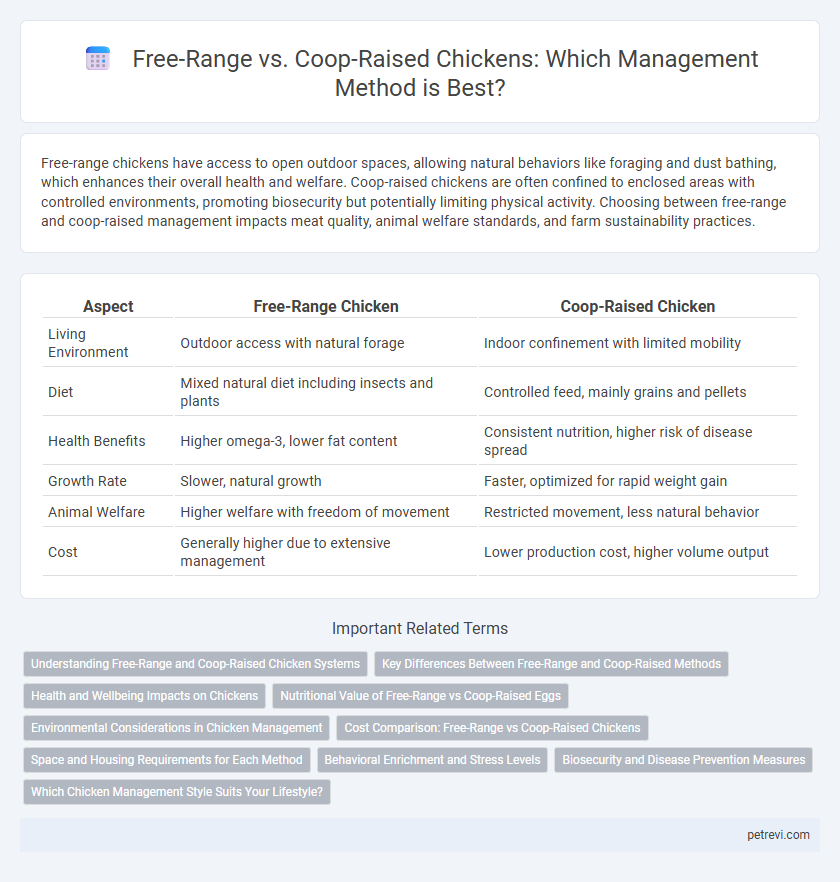Free-range chickens have access to open outdoor spaces, allowing natural behaviors like foraging and dust bathing, which enhances their overall health and welfare. Coop-raised chickens are often confined to enclosed areas with controlled environments, promoting biosecurity but potentially limiting physical activity. Choosing between free-range and coop-raised management impacts meat quality, animal welfare standards, and farm sustainability practices.
Table of Comparison
| Aspect | Free-Range Chicken | Coop-Raised Chicken |
|---|---|---|
| Living Environment | Outdoor access with natural forage | Indoor confinement with limited mobility |
| Diet | Mixed natural diet including insects and plants | Controlled feed, mainly grains and pellets |
| Health Benefits | Higher omega-3, lower fat content | Consistent nutrition, higher risk of disease spread |
| Growth Rate | Slower, natural growth | Faster, optimized for rapid weight gain |
| Animal Welfare | Higher welfare with freedom of movement | Restricted movement, less natural behavior |
| Cost | Generally higher due to extensive management | Lower production cost, higher volume output |
Understanding Free-Range and Coop-Raised Chicken Systems
Free-range chicken systems allow birds to roam outdoors, providing access to natural sunlight, fresh air, and diverse foraging opportunities that enhance their overall well-being and nutritional quality. Coop-raised chickens are confined within enclosed structures, which limit movement but offer protection from predators and environmental fluctuations, promoting consistent care and biosecurity. Understanding these management systems helps optimize poultry health, welfare standards, and product outcomes in commercial and small-scale farming.
Key Differences Between Free-Range and Coop-Raised Methods
Free-range chickens have access to outdoor spaces, allowing natural behaviors like foraging and dust bathing, which enhances animal welfare and can improve meat and egg quality. Coop-raised chickens are confined indoors with controlled environments, reducing exposure to predators and environmental fluctuations but limiting movement and natural activities. Nutritional content, growth rates, and disease risks vary significantly between the two methods, influencing farm management decisions and consumer preferences.
Health and Wellbeing Impacts on Chickens
Free-range chickens typically experience improved health and wellbeing due to increased access to natural sunlight, fresh air, and space for physical activity, which reduces stress and the incidence of diseases such as respiratory infections and foot problems. Coop-raised chickens, confined to limited space, often encounter higher risks of bacterial infections and behavioral issues like feather pecking caused by overcrowding and lack of stimulation. Studies indicate that enhanced welfare standards in free-range environments contribute to stronger immune systems and better overall growth performance in poultry.
Nutritional Value of Free-Range vs Coop-Raised Eggs
Free-range eggs typically contain higher levels of omega-3 fatty acids, vitamin D, and beta-carotene compared to coop-raised eggs due to the chickens' access to a more varied diet and natural sunlight. These nutritional enhancements contribute to better antioxidant properties and overall nutrient density in free-range eggs. Coop-raised eggs often have consistent nutrient content but generally lack the elevated micronutrients found in free-range produced eggs.
Environmental Considerations in Chicken Management
Free-range chicken management promotes biodiversity by allowing birds to forage naturally, which enhances soil health and reduces the need for chemical fertilizers. Coop-raised chickens concentrate waste in smaller areas, increasing the risk of pollution and requiring efficient manure management systems to prevent environmental degradation. Implementing sustainable practices such as rotational grazing and proper ventilation in coops can mitigate negative ecological impacts while supporting poultry health.
Cost Comparison: Free-Range vs Coop-Raised Chickens
Free-range chickens generally incur higher costs due to increased land requirements, predator protection, and varied feed expenses compared to coop-raised chickens, which benefit from controlled environments and concentrated feeding. Coop-raised systems reduce labor and infrastructure costs through automation and minimized space but may require investments in ventilation and sanitation. Evaluating the balance between these cost factors is essential for optimizing profitability in chicken management.
Space and Housing Requirements for Each Method
Free-range chickens require significantly more space, typically at least 2-3 square feet per bird indoors and 8-10 square feet in outdoor run areas, promoting natural behaviors and improved welfare. Coop-raised chickens are managed in confined spaces, often providing as little as 1.5-2 square feet per bird indoors, focusing on optimized housing design to maximize density while maintaining health standards. Adequate ventilation, clean bedding, and protection from predators are crucial in both methods but vary in scale and complexity depending on whether chickens access outdoor environments or remain coop-bound.
Behavioral Enrichment and Stress Levels
Free-range chickens exhibit higher behavioral enrichment through natural foraging, dust bathing, and increased movement, which reduces stress levels compared to coop-raised chickens confined to limited spaces. Coop-raised chickens often experience elevated cortisol levels and display signs of frustration due to restricted environments lacking stimulating activities. Providing environmental complexity in coop systems, such as perches and pecking objects, can partially mitigate stress but does not fully replicate the benefits of free-range conditions.
Biosecurity and Disease Prevention Measures
Free-range chicken management requires stringent biosecurity protocols such as controlled access points and regular health monitoring to minimize exposure to wild birds and environmental pathogens. Coop-raised chickens benefit from enclosed environments that facilitate effective sanitation practices, vaccination schedules, and quarantine measures to prevent disease outbreaks. Implementing rigorous biosecurity measures in both systems is critical to reducing risks of avian influenza, Newcastle disease, and other infectious agents.
Which Chicken Management Style Suits Your Lifestyle?
Free-range chicken management offers chickens access to outdoor spaces, promoting natural behaviors and often resulting in healthier, more flavorful meat, ideal for those valuing sustainability and animal welfare. Coop-raised chickens thrive in controlled environments with regulated temperature and protection from predators, making this method suitable for urban or small-scale farmers prioritizing ease of management and biosecurity. Choosing the right style depends on your available space, time commitment, and personal values regarding animal welfare and meat quality.
Free-Range vs Coop-Raised for Chicken Management Infographic

 petrevi.com
petrevi.com